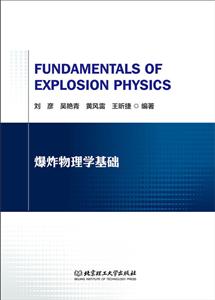預(yù)估到手價(jià)是按參與促銷(xiāo)活動(dòng)、以最優(yōu)惠的購(gòu)買(mǎi)方案計(jì)算出的價(jià)格(不含優(yōu)惠券部分),僅供參考,未必等同于實(shí)際到手價(jià)。
有劃線標(biāo)記、光盤(pán)等附件不全詳細(xì)品相說(shuō)明>>
-
>
闖進(jìn)數(shù)學(xué)世界――探秘歷史名題
-
>
中醫(yī)基礎(chǔ)理論
-
>
當(dāng)代中國(guó)政府與政治(新編21世紀(jì)公共管理系列教材)
-
>
高校軍事課教程
-
>
思想道德與法治(2021年版)
-
>
毛澤東思想和中國(guó)特色社會(huì)主義理論體系概論(2021年版)
-
>
中醫(yī)內(nèi)科學(xué)·全國(guó)中醫(yī)藥行業(yè)高等教育“十四五”規(guī)劃教材
爆炸物理學(xué)基礎(chǔ) 版權(quán)信息
- ISBN:9787568243292
- 條形碼:9787568243292 ; 978-7-5682-4329-2
- 裝幀:一般膠版紙
- 冊(cè)數(shù):暫無(wú)
- 重量:暫無(wú)
- 所屬分類:>>
爆炸物理學(xué)基礎(chǔ) 內(nèi)容簡(jiǎn)介
本書(shū)較為系統(tǒng)地闡述了爆炸物理學(xué)的基本概念、理論和方法。內(nèi)容包括爆炸的廣義定義和基本特征、波和沖擊波理論、炸藥的熱化學(xué)性質(zhì),爆轟波經(jīng)典理論、炸藥的感度與安定性,同時(shí)還對(duì)爆轟波后產(chǎn)物流動(dòng)規(guī)律及其推動(dòng)作用,爆炸的直接作用等相關(guān)問(wèn)題進(jìn)行了較為全面的闡述和分析。本書(shū)著眼于講清楚四個(gè)基本(基本概念、基本理論、基本公式推導(dǎo)及分析計(jì)算以及基本實(shí)驗(yàn)研究方法),理論內(nèi)容深入充實(shí),對(duì)工程應(yīng)用有實(shí)際參考意義。本書(shū)可作為國(guó)防軍工院校相關(guān)專業(yè)和學(xué)科的教材,同時(shí)還可作為爆炸技術(shù)及應(yīng)用等各軍工專業(yè)以及工程爆破技術(shù)、石油化工、采礦與建井、水利、電力、交通等民用部門(mén)相近專業(yè)本科生、研究生和科技人員的參考書(shū)。
爆炸物理學(xué)基礎(chǔ) 目錄
Chapter 1 Introduction 001
§1.1 Explosion Phenomena and Characteristics 001
1.1.1 Explosion Phenomenon 001
1.1.2 Generalized Definition of Explosion 004
§1.2 Fundamentals of Thermodynamics 004
1.2.1 Some Important Concepts and Zeroth Law of Thermodynamics 004
1.2.2 First Law of Thermodynamics 006
1.2.3 Second Law of Thermodynamics 014
1.2.4 Helmholtz Free Energy and Gibbs Free Energy 017
§1.3 Properties of Gas and Equations of State 023
1.3.1 Properties of Gases 023
1.3.2 Equations of State 025
Chapter 2 Waves 029
§2.1 Concepts 029
§2.2 Sound Wave 032
§2.3 One-Dimensional Plane Isentropic Flow of Gas 035
Chapter 3 Shock Wave 050
§3.1 Introduction 050
§3.2 Basic Equations of Shock Wave 050
§3.3 Plane Shock Wave in Air 053
§3.4 Characters of Shock Wave 057
§3.5 Isentrope, Rayleigh Line and Hugoniot 060
§3.6 Reflection of Shock Wave 063
Chapter 4 Thermochemistry of Explosive 067
§4.1 Explosion Heat 067
4.1.1 Experimental Measurement of Explosion Heat 067
4.1.2 Calculation of Explosion Heat 070
4.1.3 Ways of Improving the Explosion Heat 072
§4.2 Determination of Explosion Temperature 074
4.2.1 Experimental Measurement of Explosion Temperature 074
4.2.2 Theoretical Calculation of Explosion Temperature 076
4.2.3 Ways to Change Explosion Temperature 080
§4.3 Equation of Explosion Reaction 081
4.3.1 Theoretical Calculation of the Equation of Explosion Reaction 081
4.3.2 Reaction Equation of the First Kind of Explosives 083
4.3.3 Reaction Equation of the Second Kind of Explosives 085
4.3.4 Simplified Rule for Determining the Equations of Explosion Reaction 086
§4.4 Calculation for the Volume of Explosion Gases 087
Chapter 5 Detonation Theory 089
§5.1 The Hydrodynamic Theory of Detonation Wave 090
§5.2 Zeldovich-von Neumann-Doering Theory 093
§5.3 Taylor Wave 096
§5.4 Detonation Shock Dynamics 097
§5.5 Detonation Wave Parameter Measurements 099
5.5.1 Reaction-zone Measurements 099
5.5.2 Detonation Wave Velocity Measurement 101
5.5.3 Experimental Measurement of C-J Pressure 104
§5.6 Detonation Wave Parameters Calculation Methods 108
§5.7 Factors Affecting Detonation Wave Propagation 116
5.7.1 Diameter Effects: 2-D Steady Detonation 116
5.7.2 Detonation Velocity vs. Diameter 118
5.7.3 Factors Affecting the Critical Diameter of Charge 119
Chapter 6 Ignition & Initiation of Explosives 122
§6.1 Thermal Explosion Theory of Explosives 122
6.1.1 The Physical Process of Thermal Explosion 122
6.1.2 Theory Model of Thermal Explosion 123
6.1.3 Thermal Sensitivity of Explosives 126
§6.2 Shock Initiation of Explosives 131
6.2.1 Shock Initiation of Homogeneous Explosives 132
6.2.2 Shock Initiation of Heterogeneous Explosives 136
6.2.3 Hot Spots and Explosive Ignition 137
6.2.4 Ignition Modelling 139
§6.3 Non-shock Initiation of Explosives 143
6.3.1 Initiation of Explosion by Friction 143
6.3.2 Initiation by Friction of Explosion in Liquids 146
6.3.3 Initiation of Explosion in Solids: the Influence of Grit 149
6.3.4 Initiation by Impact of Explosion in Solids 153
§6.4 Sensitivity Evaluation of Explosives 159
6.4.1 Mechanically-Confined Cook-off Tests 159
6.4.2 Drop-weight Test 165
6.4.3 Susan Test 169
6.4.4 Steven Test 170
Chapter 7 Movement of Detonation Products 174
§7.1 Expansion of Detonation Products 174
§7.2 Impulse Acting on the Rigid Wall 178
§7.3 Driving Effects on Piston 183
§7.4 Acceleration of the Cylinder Shell 188
7.4.1 Energy Model 188
7.4.2 Momentum Model for Calculating 194
7.4.3 Gurney Model for Calculating the Fragment Velocity 198
Chapter 8 Initial Shock Wave Parameters Calculation at the Interface of
Compressible Solid 203
§8.1 Introduction 203
§8.2 Interface Between Explosive and Compressible Solid 205
8.2.1 The Case at 205
8.2.2 The Case at 207
§8.3 Interface Between Compressible Solids 212
§8.4 Shock Wave Transmission and Reflection 214
8.4.1 Impedance Matching Technique 215
8.4.2 Transmission 217
8.4.3 Reflection at the Free Surface 219
References 226
爆炸物理學(xué)基礎(chǔ) 作者簡(jiǎn)介
劉彥,1975年12月出生,北京理工大學(xué)教授,博士生導(dǎo)師。長(zhǎng)期講授爆炸物理學(xué)課程,長(zhǎng)期從事常規(guī)戰(zhàn)斗部高效毀傷及評(píng)估技術(shù)研究,取得了若干原創(chuàng)性研究成果,獲省部級(jí)科技進(jìn)步一等獎(jiǎng)2項(xiàng)、二等獎(jiǎng)1項(xiàng),入選教育部新世紀(jì)優(yōu)秀人才計(jì)劃。
- >
中國(guó)歷史的瞬間
- >
大紅狗在馬戲團(tuán)-大紅狗克里弗-助人
- >
唐代進(jìn)士錄
- >
名家?guī)阕x魯迅:故事新編
- >
伊索寓言-世界文學(xué)名著典藏-全譯本
- >
企鵝口袋書(shū)系列·偉大的思想20:論自然選擇(英漢雙語(yǔ))
- >
小考拉的故事-套裝共3冊(cè)
- >
巴金-再思錄
















